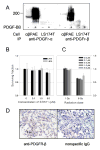Effect of platelet-derived growth factor receptor-beta inhibition with STI571 on radioimmunotherapy
- PMID: 16140951
- PMCID: PMC1363769
- DOI: 10.1158/0008-5472.CAN-04-3991
Effect of platelet-derived growth factor receptor-beta inhibition with STI571 on radioimmunotherapy
Abstract
Whereas radioimmunotherapy of hematologic malignancies has evolved into a viable treatment option, the responses of solid tumors to radioimmunotherapy are discouraging. The likely cause of this problem is the interstitial hypertension inherent to all solid tumors. Remarkable improvements in tumor responses to radioimmunotherapy were discovered after the inclusion of STI571 in the therapy regimen. A combination of the tumor stroma-reactive STI571, a potent platelet-derived growth factor receptor-beta (PDGFr-beta) antagonist, and the tumor-seeking radiolabeled antibody B72.3 yielded long-lasting growth arrest of the human colorectal adenocarcinoma LS174T grown as s.c. xenografts in athymic mice. The interaction of STI571 with the stromal PDGFr-beta reduced tumor interstitial fluid pressure (P(IF)) by >50% and in so doing improved the uptake of B72.3. The attenuation of P(IF) also had a positive effect on the homogeneity of antibody distribution. These effects were dose-dependent and under optimized dosing conditions allowed for a 2.45 times increase in the tumor uptake of B72.3 as determined in the biodistribution studies. Single-photon emission computed tomography imaging studies substantiated these results and indicated that the homogeneity of the radioisotope distribution was also much improved when compared with the control mice. The increased uptake of radioimmunotherapy into the tumor resulted in >400% increase in the tumor absorbed radiation doses in STI571 + radioimmunotherapy-treated mice compared with PBS + radioimmunotherapy-treated mice. The improved antibody uptake in response to the attenuation of tumor P(IF) was identified as the primary reason for the growth arrest of the STI571 + radioimmunotherapy-treated tumors. Two related causes were also identified: (a) the improved homogeneity of monoclonal antibody distribution in tumor and (b) the increased tumor radiosensitivity resulting from the improved tumor oxygenation.
Figures




References
-
- Vose JM, Wahl RL, Saleh M, et al. Multicenter phase II study of iodine-131 tositumomab for chemotherapy-relapsed/refractory low-grade and transformed low-grade B-cell non-Hodgkin’s lymphomas. J Clin Oncol. 2000;18:1316–23. - PubMed
-
- Kaminski MS, Zelenetz AD, Press OW, et al. Pivotal study of iodine I 131 tositumomab for chemotherapy-refractory low-grade or transformed low-grade B-cell non-Hodgkin’s lymphomas. J Clin Oncol. 2001;19:3918–28. - PubMed
-
- Witzig TE, White CA, Gordon LI, Wiseman GA, Emmanouilides C, Murray JL, Lister J, Multani PS. Safety of yttrium-90 ibritumomab tiuxetan radioimmunotherapy for relapsed low-grade, follicular, or transformed non-hodgkin’s lymphoma. J Clin Oncol. 2003;21:1263–70. - PubMed
-
- Behr TM, Goldenberg DM, Becker WS. Radioimmunotherapy of solid tumors: a review “of mice and men”. Hybridoma. 1997;16:101–7. - PubMed
-
- Tempero M, Leichner P, Baranowska-Kortylewicz J, et al. High-dose therapy with 90Yttrium-labeled monoclonal antibody CC49: a phase I trial. Clin Cancer Res. 2000;6:3095–102. - PubMed
Publication types
MeSH terms
Substances
Grants and funding
LinkOut - more resources
Full Text Sources
Other Literature Sources
Medical
Miscellaneous

